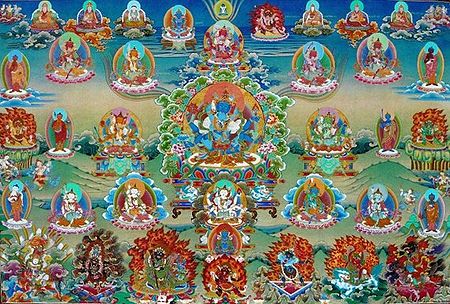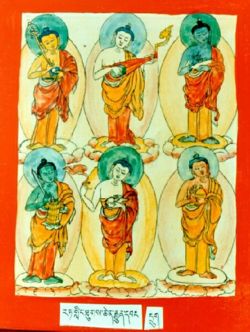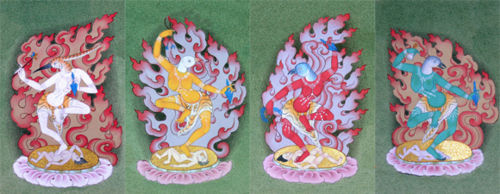Hundred peaceful and wrathful deities
The Hundred Peaceful and Wrathful Deities (Tib. ཞི་ཁྲོ་རིགས་བརྒྱ་, shyitro rik gya, Wyl. zhi khro rigs brgya) include the forty-two peaceful deities and fifty-eight wrathful deities. They feature in several practices and cycles of teachings, most notably the Tibetan Book of the Dead and the Guhyagarbha Tantra, which is the primary source describing this mandala.
Forty-two Peaceful Deities

The forty-two peaceful deities (Tib. ཞི་བའི་ལྷ་ཞེ་གཉིས་, shyiwé lha shyé nyi; Wyl. zhi ba'i lha zhe gnyis) are:
1) Samantabadra
2) Samantabadri
3-7) The Five Male Buddhas of the Five Families
Buddhas of the five families (Skt. jinakula; Tib. རྒྱལ་བ་རིགས་ལྔ་, Wyl. rgyal ba rigs lnga) — the five peaceful buddhas of the sambhogakaya:
- Vairochana, buddha family
- Akshobhya, vajra family
- Ratnasambhava, ratna family
- Amitabha, padma family
- Amoghasiddhi, karma family
8-12) The Five Female Buddhas of the Five Families
The five female buddhas of the five families, also known as the five mothers (Tib. ཡུམ་ལྔ་, Wyl. yum lnga) are:
- Dhatvishvari also known as Vajra Datvishvari or White Tara, the consort of Vairochana, who represents the purity of the element space
- Buddhalochana the consort of Akshobhya, who represents the purity of the element earth
- Mamaki the consort of Ratnasambhava, who represents the purity of the element water
- Pandaravasini the consort of Amitabha, who represents the purity of the element fire
- Samayatara also known as Green Tara, the consort of Amoghasiddhi, who represents the purity of the element wind
13-20) The Eight Male Bodhisattvas
Eight Great Bodhisattvas, or 'Eight Close Sons' (Skt. aṣṭa utaputra; Tib. ཉེ་བའི་སྲས་བརྒྱད་, nyewé sé gyé, Wyl. nye ba'i sras brgyad) — the main bodhisattvas in the retinue of Buddha Shakyamuni:
| This section contains Tibetan script. Without proper Tibetan rendering support configured, you may see other symbols instead of Tibetan script. |
- Mañjushri
- Avalokiteshvara
- Vajrapani
- Maitreya
- Kshitigarbha
- Akashagarbha
- Sarvanivaranavishkambhin
- Samantabhadra
Read more about them
21-28) The Eight Female Bodhisattvas
The eight female bodhisattvas (Tib. བྱང་ཆུབ་སེམས་མ་བརྒྱད་, changchub semma gyé, Wyl. byang chub sems ma brgyad) are also referred to as the eight offering goddesses. They are the consorts of the eight great bodhisattvas:
- Goddess of Beauty (Skt. Lāsyā; Tib. Gekpama; Wyl. sgeg pa ma) the consort of Kshitigarbha
- Goddess of Garlands (Skt. Mālā; Tib. Trengwama; Wyl. phreng ba ma) the consort of Akashagarbha
- Goddess of Song (Skt. Gītā; Tib. Luma; Wyl. glu ma) the consort of Vajrapani
- Goddess of Dance (Skt. Nṛtyā; Tib. Garma; Wyl. gar ma) the consort of Avalokiteshvara
- Goddess of Flowers (Skt. Puṣpā; Tib. Metokma Wyl. me tog ma) the consort of Sarvanivaranavishkambhin
- Goddess of Incense (Skt. Dhūpā; Tib. Dukpöma; Wyl. bdug spos ma) the consort of Maitreya
- Goddess of Light (Skt. Ālokā; Tib. Marmema or Nangselma; Wyl. mar me ma) the consort of Samantabhadra
- Goddess of Perfume (Skt. Gandhā; Tib. Drichabma; Wyl. dri chab ma) the consort of Mañjushri
Symbolically they represent the pure state of sense objects.
29-34) The Six Munis

The Six Munis (Skt.; Tib. ཐུབ་པ་དྲུག་, Tubpa Druk, Wyl. thub pa drug) are the supreme nirmanakaya buddhas for each of the six classes of beings. They are:
- Indra Kaushika (Skt. Kauśika; Tib. དབང་པོ་བརྒྱ་བྱིན་ or ལྷའི་དབང་པོ་བརྒྱ་བྱིན་, Wangpo Gyajin, Wyl. dbang po brgya byin) for the god realms
- Vemachitra (Skt. Vemacitra; Tib. ཐགས་བཟང་རིས་ or ཐག་བཟང་རིས་, Taksangri, Wyl. thags bzang ris) for the demi-gods or asura realms
- Shakyamuni (Skt. Śākyamuni; Tib. ཤཱཀྱ་ཐབ་པ་, Wyl. shAkya thub pa) for the human realm
- *Shravasingha, *Dhruvasiṃha or *Siṃhapradyota (Skt.; Tib. སེང་གེ་རབ་བརྟན་, Sengé Rabten, Wyl. seng ge rab brtan) for the animal realm
- Jvalamukhadeva (Skt. Jvālāmukhadeva; Tib. ཁ་འབར་དེ་བ་, Khabar Dewa, Wyl. kha ‘bar de ba) for the preta realms
- Dharmaraja (Skt. Dharmarāja; Tib. ཆོས་ཀྱི་རྒྱལ་པོ་, Chökyi Gyalpo, Wyl. chos kyi rgyal po) for the hell realms
35-38) The Four Male Gate Keepers
The four male gatekeepers (Tib. སྒོ་བ་ཡབ་བཞི་, gowa yab shyi, Wyl. sgo ba yab bzhi) are:
- Achala, guarding the east gate (or Vijaya, or Mahabala?)
- Yamantaka, guarding the south gate
- Hayagriva, guarding the west gate
- Amritakundali, guarding the north gate
39-42) The Four Female Gate Keepers
The four female gatekeepers (Tib. སྒོ་མ་བཞི་, go ma shyi, Wyl. sgo ma bzhi) are:
- Ankusha (Skt. Aṅkuśā; Wyl. lcags kyu ma or rta gdong ma) also called 'Horse Face' or 'Iron Hook', guarding the east gate and in union with Vijaya (or Achala?)
- Pasha (Skt. Pāśā; Wyl. zhags pa ma or phag gdong ma) also called 'Sow Face' or 'the Noose', guarding the south gate and in union with Yamantaka
- Shrinkhala (Skt. Śṛṅkhalā; Wyl. lcags sgrog ma or seng gdong ma) also called 'Lion Face' or 'Iron Chain', guarding the west gate and in union with Hayagriva
- Ghanta (Skt. Ghaṇtā; Wyl. dril bu ma or spyang gdong ma) also called 'Wolf Face' or 'the Bell', guarding the north gate and in union with Amritakundali.
Fifty-eight Wrathful Deities
The fifty-eight wrathful deities are:
1-10) The Five Wrathful Herukas and their Five Consorts
The five wrathful herukas and their five consorts—the wrathful aspect of the buddhas of the five families and of the five female buddhas—are:
- Buddhaheruka and his consort Buddhakrodhishvari;
- Vajraheruka and his consort Vajrarodhishvari;
- Ratnaheruka and his consort Ratnarodhishvari;
- Padmaheruka and his consort Padmakrodhishvari and
- Karmaheruka and his consort Karmakrodhishvari.
11-18) The Eight Wrathful Females
The eight wrathful females or eight gaurima (Skt. gaurī; Tib. གཽ་རི་མ་བརྒྱད་, gaurima gyé, Wyl. gau ri ma brgyad) are:
- Gauri (Skt. Gaurī;[1] Wyl. ko'u ri), The White Lady (dkar mo)[2]
- Pukkasi (Skt. Pukkasī; Wyl. pus ka si), The Fragrant Lady (spos mo)
- Chauri (Skt. Caurī; Wyl. tso'u ri), The Thief Lady (chom rkun ma)
- Ghasmari (Skt. Ghasmarī; Wyl. kas ma ri), The Voracious Lady (sme sha can)
- Pramoha (Skt. Pramohā; Wyl. pra mo), The Bewildered Lady (rab tu rmongs ma)
- Chandali (Skt. Caṇḍālī; Wyl. tsan dha li), The Fierce Lady (gtum mo)
- Vetali (Skt. Vetālī; Wyl. be'e ta li), The Undead Lady (ro langs ma)
- Shmashani (Skt. Śmaśānī; Wyl. sme sha ni), The Charnel Ground Lady (dur khrod ma)
19-26) The Eight Tramen
The eight tramen (Skt. piśacī; Tib. ཕྲ་མེན་བརྒྱད་, tramen gyé, Wyl. phra men brgyad), or eight singhama (སིམ་ཧ་བརྒྱད་, sim ha brgyad) are animal-headed deities (tramen literally means 'hybrid'). They are:
- Simhamukha (Skt. Siṃhamukhā)[3], The Lion-Faced Lady (seng gdong ma)
- Vyaghrimukha (Skt. Vyāghramukhā) The Tiger-Faced Lady (stag gdong ma)
- Srigalamukha (Skt. Śṛgālamukhā) The Jackal-Faced Lady (wa gdong ma)
- Shvanamukha (Skt. Śvanamukhā) The Wolf-Faced Lady (spyang ki)
- Gridhamukha (Skt. Gṛdhramukhā) The Vulture-Faced Lady (bya rgod)
- Kangkamukha (Skt. Kaṅkamukhā; Wyl. kang ka mu kha) The Heron-Faced Lady (dur bya)
- Kakamukha (Skt. Kākamukhā) The Crow-Faced Lady (bya rog)
- Ulumukha (Skt. Ulūkamukhā) The Owl-Faced Lady ( 'ug pa'i gdong can ma)
27-30) The Four Female Gatekeepers
The four female gatekeepers (Tib. སྒོ་མ་བཞི་, go ma shyi, Wyl. sgo ma bzhi) are:
- Ankusha (Skt. Aṅkuśā; Wyl. lcags kyu ma or rta gdong ma) also called 'Horse Face' or 'Iron Hook', guarding the east gate and in union with Vijaya (or Achala?)
- Pasha (Skt. Pāśā; Wyl. zhags pa ma or phag gdong ma) also called 'Sow Face' or 'the Noose', guarding the south gate and in union with Yamantaka
- Shrinkhala (Skt. Śṛṅkhalā; Wyl. lcags sgrog ma or seng gdong ma) also called 'Lion Face' or 'Iron Chain', guarding the west gate and in union with Hayagriva
- Ghanta (Skt. Ghaṇtā; Wyl. dril bu ma or spyang gdong ma) also called 'Wolf Face' or 'the Bell', guarding the north gate and in union with Amritakundali.
31-58) The Twenty-eight Ishvaris
The twenty-eight ishvaris (Skt. īśvarī; Tib. དབང་ཕྱུག་མ་ཉེར་བརྒྱད་, wangchukma nyer gyé, Wyl. dbang phyug ma nyer brgyad)
The twenty-eight ishvaris are composed of four groups of six yoginis corresponding to the four activities, and of the four female outer-gate keepers:
1. The six yoginis corresponding to the activity of pacifying:

- Rakshasi (white)
- Brahmi
- Mahadevi
- Lobha
- Kumari
- Indrani
2. The six yoginis corresponding to the activity of increasing:

- Vajra
- Shanti
- Amrita
- Chandra
- Danda
- Rakshasi (dark yellow)
3. The six yoginis corresponding to the activity of magnetizing:

- Bhakshini
- Rati
- Mahabala
- Rakshasi (pale red)
- Kama
- Vasuraksha
4. The six yoginis corresponding to the activity of subjugating:

- Vayudevi
- Nari
- Varahi
- Nanda
- Mahahastini
- Varunadevi
5. The last group is composed of the four female outer-gate keepers.

59-60) Chemchok Heruka and his Consort
The fifty-eight wrathful deities become sixty when you add Chemchok Heruka and his consort Krodhishvari, who are the wrathful aspects of Samantabhadra and Samantabhadri.
Shyitro Empowerments Given to the Rigpa Sangha
- H.H. Dilgo Khyentse Rinpoche, London, UK, 1 July 1987
- H.H. Penor Rinpoche, London, UK, 11 November 1988 (Namchö terma of Migyur Dorje)
- Dodrupchen Rinpoche, Cassan, France, 6 & 7 August 1991 (terma of Karma Lingpa)
- Tulku Pegyal Rinpoche, Lerab Ling, 16 August 1997, Shyitro empowerment from the cycle of Jatsön Nyingpo, Könchok Chidü lineage.
- Tulku Pegyal Rinpoche, Amsterdam, Netherlands, 27 September 1997, Karling Shyitro empowerment[4]
- Tulku Pegyal Rinpoche, L'Orangeraie, Paris, 5 October 1997, Empowerment of Hundred peaceful and wrathful deities.[5]
- Tulku Pegyal Rinpoche, Zürich, 12 October 1997, Shyitro empowerment from the cycle of Jatsön Nyingpo, Könchok Chidü lineage
- Trulshik Rinpoche: 26-27 June 2003, Lerab Ling, medium-length empowerment of the Peaceful and of the Wrathful Deities from the tantra known as the Web of Magical Illusion
- Khenpo Namdrol, Lerab Ling, 27 July 2005: empowerment from Khenpo Jikmé Phuntsok's Magical Net cycle (sgyu 'phrul gsang snying sgrub skor)
- Yangthang Rinpoche, from the Longchen Nyingtik cycle based on the empowerment manual by Dilgo Khyentse Rinpoche[6], in Lerab Ling and through international streaming, 2-3 August 2012.
- Khenchen Pema Sherab, from the Longchen Nyingtik cycle based on the empowerment manual by Dilgo Khyentse Rinpoche, Lerab Ling, 23-24 June 2017. Only the vase empowerment was given.
- Khenchen Pema Sherab, Lerab Ling, from the Longchen Nyingtik cycle based on the empowerment manual by Dilgo Khyentse Rinpoche:
- 15 & 16 June 2019. Only the vase empowerment was given.
- Tulku Rigdzin Pema Rinpoche, Lerab Ling, France, 17 December 2022: Karling Shyitro (Zabchö Shitro Gongpa Rangdrol)
- Tulku Rigdzin Pema Rinpoche, Amsterdam, Netherlands, 22 September 2024: Karling Shyitro Torma Empowerment (Zabchö Shitro Gongpa Rangdrol), along with oral transmission of A Daily Practice for the Peaceful and Wrathful Deities of the Self-Liberated Wisdom Mind by Dodrupchen Jigme Trinle Özer
- Shechen Rabjam Rinpoche, Lerab Ling, France, 12-13 September 2025. Longchen Nyingtik empowerment from Chapter 1 of Dilgo Khyentse Rinpoche’s A Feast that Delights the Fortunate Ones and Reveals the Nectar of the Profound and Secret, A Garland of Liturgies for Bestowing the General and Specific Empowerments of the Three Roots of the Great Perfection’s Heart-Essence of the Vast Expanse
Notes
- ↑ Unless marked with an asterisk, the Sanskrit has been attested in various tantras translated for 84.000 or other sources.
- ↑ The translations into Tibetan are taken from Longchenpa's Dispelling Darkness in the Ten Directions
- ↑ The Sanskrit words of all eight goddesses are only attested in Monier Williams
- ↑ Information provided by Eric Soyeux.
- ↑ Information based on notes and reports from students; event not yet in Treasury of Wisdom database.
- ↑ A Feast of the Pleasant and Fortunate Ones which Opens the Door to the Profound and Secret Amṛta: A Garland of Ritual Arrangements for Bestowing the Empowerments of the General and Specific Practices of the Three Roots of the Heart Essence of the Vast Expanse
Further Reading
- Sogyal Rinpoche, The Tibetan Book of Living and Dying, revised and updated edition (Harper San Francisco, 2002), page 284.
